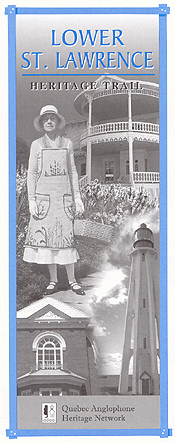
River and sea run together in the broad waters of the Lower St. Lawrence. Though fields first cleared by French farmers 250 years ago still ripen in rolling strips of green between historic towns and villages, a number of these settlements also have Anglophone roots, some dating to the close of the Seven Years’ War.
The St. Lawrence River was the main route for trade and settlement in New France. When France ceded Canada to Britain in 1763, title to seigneurial lands passed to British landlords. Their early efforts to develop the region have helped shape the growth of Lower St. Lawrence communities.
As England’s demand for wood surged during the Napoleonic Wars, the forest industry became especially active along the great river. By the early 1800s, logging camps and sawmills were established near its major tributaries as far as the Gaspé coast. Many of the towns and villages along this Trail began as millsites.
Though the lumber trade and railways eventually attracted a few British settlers, their presence in the Lower St. Lawrence was largely eclipsed by the rapid growth of francophone society in the 19th century. Except for Metis where descendants of Scottish settlers still form a year-round community, Anglophone ties to the region are mostly seasonal.
Many of the landmarks and points of interest along this Trail are found in historic resort colonies, which sprang up in the late 1800s to accommodate summer vacationers. Affluent Montrealers established several thriving summer communities here. Though the old hotels have vanished, the annual pilgrimage to grand summer homes is a ritual closely observed by many English Quebecers and their out-of-province kin.
HOW TO GET THERE 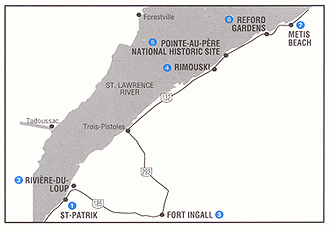 A two-hour drive east of Quebec City on Autoroute 20 leads to the Lower St. Lawrence Heritage Trail region. Exit at the village of Notre-Dame-de-Portage and continue east on Route 132.
A two-hour drive east of Quebec City on Autoroute 20 leads to the Lower St. Lawrence Heritage Trail region. Exit at the village of Notre-Dame-de-Portage and continue east on Route 132.
ST. PATRICK (300 to 370 rue Fraser, Riviere-du-Loup)
Just east of Notre-Dame-du-Portage along a leafy, winding stretch of Route 132, a dozen or so magnificent 19th century homes perch above the river on a bluff. This is the prestigious vacation community of St. Patrick where generations of English-speaking families have congregated each summer since the 1870s. Once a separate municipality, the community now constitutes the historic Vieux St-Patrice district of Rivière-du-Loup.
Canada’s first prime minister, John A McDonald, summered here between 1873 and 1890. His rambling Victorian villa called Les Rochers (336 rue Fraser) was subsequently owned by CPR chief Thomas George Shaughnessy and Air Canada president Herbert Symington before becoming the property of the Canadian Heritage of Quebec charitable organization in 1981. It now operates as a bed and breakfast.
For two decades, the house at 342 rue Fraser belonged to the family of Louis Saint-Laurent, prime minister of Canada from 1948-1957.
RIVIÈRE-DU-LOUP (Pop. 18,200)
This pretty hillside city overlooking the Lower St. Lawrence Islands was first named Fraserville after the seigneurial family who controlled Riviere-du-Loup’s early economic development.
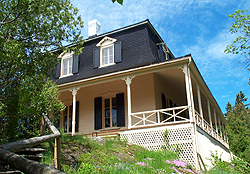 Originally centred round the mouth of the river of the same name, the Rivière-du-Loup seigneury had belonged to Charles Aubert de la Chesnaye, a leading merchant in New France. It was acquired by Quebec’s first British governor, James Murray, and subsequently sold to Alexander Fraser, son of a Scottish infantry officer who fought on the Plains of Abraham, and his French-Canadian wife, Marie Allaire.
Originally centred round the mouth of the river of the same name, the Rivière-du-Loup seigneury had belonged to Charles Aubert de la Chesnaye, a leading merchant in New France. It was acquired by Quebec’s first British governor, James Murray, and subsequently sold to Alexander Fraser, son of a Scottish infantry officer who fought on the Plains of Abraham, and his French-Canadian wife, Marie Allaire.
Under Alexander Fraser’s seigneurship, the settlement gained its first woolen mills and a sawmill in 1818. In partnership with Quebec City entrepreneurs Henry and John Caldwell, Fraser began cutting the immense spruce forests of the Temiscouata Valley on which the city’s lumber, pulp and paper industries are based.
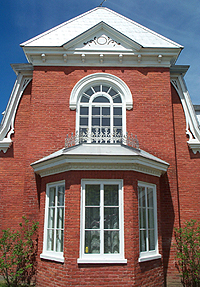 Today the Fraser Manor House (1830) at 32 rue Fraser is a classified historical site open to visitors. This masterful example of Second Empire-style architecture has been exquisitely restored by a local heritage preservation society. Seigneur Fraser himself is buried in a little Protestant cemetery beside St Bartholemew’s Anglican Church (1841), situated at 15 rue du Domaine.
Today the Fraser Manor House (1830) at 32 rue Fraser is a classified historical site open to visitors. This masterful example of Second Empire-style architecture has been exquisitely restored by a local heritage preservation society. Seigneur Fraser himself is buried in a little Protestant cemetery beside St Bartholemew’s Anglican Church (1841), situated at 15 rue du Domaine.
Rivière-du-Loup became a major railway hub in the 1860s, first as a terminal of the Grand Trunk Railway and later as train-repair centre for the Intercolonial and Temiscouata railways. Railway jobs attracted hundreds of new workers, including Scots from the Maritimes who settled near the tracks along rue Saint André -- a street still known locally as rue des Anglais.
A wealth of architectural styles are found in the historic district bounded by Lafontaine, Hotel-de-Ville, Iberville and Du Domaine streets. One of the most distinctive is the former American consulate (1, rue Iberville), built around 1850, featuring a broad half-moon gallery. A guide to historical markers is available from the local Visitor’s Centre.
Musée du Bas-Saint-Laurent
300 rue St-Pierre
(418) 862 7547
Fraser Manor House Historical Site
32, rue Fraser
Visitor Centre
189 rue Hôtel-de-Ville.
(418) 867 3015
FORT INGALL
National Historic Site, Cabano
From Rivière du Loup, an hour’s drive east on Route 185 leads to the site of a reconstructed British fort on the shores of lovely Lake Temiscouata. This road, which now carries the Trans Canada Highway from Quebec to the Maritimes, traces
part of an ancient trail first used by Micmac and Malecite Indians. The trail ran from the Saint Lawrence via Lake Temiscouata and the Madawaska and Saint John rivers to Acadia.
 Although combat was averted, a longstanding boundary dispute between Maine and New Brunswick led to a tense standoff over ownership of forest land in the Aroostook and Madawaska valleys in 1839. Fort Ingall was one of four posts the British Army built in eastern Quebec and northern New Brunswick to guard the so-called timber route against American invasion. Troops were stationed at Fort Ingall for three years until the dispute was resolved by the Webster-Ashburton Treaty in 1842.
Although combat was averted, a longstanding boundary dispute between Maine and New Brunswick led to a tense standoff over ownership of forest land in the Aroostook and Madawaska valleys in 1839. Fort Ingall was one of four posts the British Army built in eastern Quebec and northern New Brunswick to guard the so-called timber route against American invasion. Troops were stationed at Fort Ingall for three years until the dispute was resolved by the Webster-Ashburton Treaty in 1842.
The compound, now the property of the Société d’Histoire et d'Archéologie du Témiscouata, includes barracks, officer’s quarters, mess hall, guardhouse, bakery and jail, as well as exhibits on the demanding life of the frontier soldier. An English-style rose garden now complements the visit.
81 rue Caldwell
Cabano, Quebec
(418) 854-2375
RIMOUSKI (Pop. 50,000)
Once part of a French seigneury originally granted in 1688, this maritime city is the capital of the Lower St. Lawrence and eastern Quebec’s largest urban centre. Maison Lamontagne, the city’s oldest house (circa 1750) provides an interesting backdrop for a unique exhibit on the evolution of domestic architecture and is one of the rare structures in this part of Quebec which date to the French régime. Along rue St-Germain Ouest visitors will find some of the region’s best dining opportunities.
A small fishing and farming settlement was located near the mouth of the Rimouski River in the 17th and 18th centuries but it wasn’t until after the establishment of lumber camps in the 1820s that growth took off. Development accelerated when Quebec City wood merchants, including William Price, bought up cutting rights and built mills. The Price Porritt Pulp and Paper Company was founded here in 1902.
During the town’s lumbering heyday, a number of English-speaking families connected with the Price Bros. sawmill and shingle factory lived in Rimouski’s Nazareth district, on the west side of the river across from Hydro-Quebec¹s headquarters on Boul. René-Lepage.
Forestry declined after a fire that started at the Price complex in May 1950 devastated much of the city. Today Rimouski is home to the Université de Quebec’s marine research institute. Fewer than 300 Anglophones remain.
Maison Lamontagne
707 Route 132 (Boul. du Rivage, Rimouski-Est)
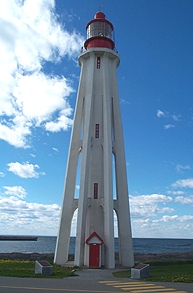 POINT AU PÈRE LIGHTHOUSE
POINT AU PÈRE LIGHTHOUSE
National Historic Site
To learn more about the maritime heritage of the Lower St. Lawrence, be sure to visit the Musée de la mer, located at this historic lighthouse settlement in Father Point (Point-au-Père), just east of Rimouski on Route 132. Before modern telecommunications, lighthouses were essential aids to navigation in the St. Lawrence. This one, built in 1909, is the second tallest in Canada. The Parks Canada site includes the original house and outbuildings where generations of lighthouse keepers and their families lived.
The adjacent maritime museum commemorates the 1914 sinking of the Canadian ocean liner Empress of Ireland, a disaster which claimed 1,012 lives. This thoroughly compelling exhibit features relics taken by divers from the shipwreck itself and a dramatic 3-D film presentation that documents the events which led to the tragedy.
Musée de la mer
(418) 724-6214
REFORD GARDENS (Jardins de Métis)
Grand-Métis
A breathtaking feast of flowers and trees, these world-famous gardens are a tribute to Quebec’s English horticultural tradition. Taking advantage of local landforms and the sea-tempered climate, Elsie Reford spent more than 30 years transforming 25 acres of dense spruce forest into this eclectic living masterpiece of colour and texture. Her great-grandson Alexander now carries on the family tradition as the garden’s director.
 Born in Perth, Ontario, Elsie Reford was the niece of George Stephen, a Montreal financier and founding president of the Canadian Pacific Railway. Her passion for gardening emerged after inheriting her uncle’s summer home near the mouth of the Metis River. Through her husband’s shipping agency, Reford Shipping in the Port of Montreal, Elsie was able to collect plant specimens from all over the world, including the rare Himalayan Blue Poppy. More than 3,000 plant species and varieties thrive here. The gardens are a great place to enjoy a leisurely picnic.
Born in Perth, Ontario, Elsie Reford was the niece of George Stephen, a Montreal financier and founding president of the Canadian Pacific Railway. Her passion for gardening emerged after inheriting her uncle’s summer home near the mouth of the Metis River. Through her husband’s shipping agency, Reford Shipping in the Port of Montreal, Elsie was able to collect plant specimens from all over the world, including the rare Himalayan Blue Poppy. More than 3,000 plant species and varieties thrive here. The gardens are a great place to enjoy a leisurely picnic.
Reford Gardens
200 route 132, Grand-Métis
(418) 775-2221
Website: www.refordgardens.com
METIS BEACH
At its peak in the 1930s, a dozen hotels operated in this historic summer resort colony, now officially known as Métis-sur-Mer. Today an air of faded grandeur clings to the village like a sea mist. Gone are the old hotels, but the manicured cedar hedges, wild roses and roomy villas along the shore still draw admiring gazes. An organization dedicated to preserving the region's English-speaking heritage, Heritage Lower St. Lawrence, is headquartered here.
Though the Seigneury of Metis was originally granted in 1675 to a French nobleman, Sieur Jean Baptiste de Peiras, nearly a century and a half would pass before European homesteaders arrived, led by a Scottish-born banker from Quebec City named John McNider. To this day, Metis Beach remains a predominantly English-speaking community.
In 1818 McNider bought the Metis seigneury and had a schooner built, the Rebecca, in which he plied between Quebec and his new estate. Aboard her, forty pioneer families sailed to their new country, earning the vessel the nickname, Mayflower of Metis. Most hailed from Scotland’s county Thrane, McNider’s birthplace. His manor house, now gone, was built at Lighthouse Point.
Metis has a wealth of historical buildings, most of them connected with the village’s growth as a vacation retreat in the 19th century and erected by local craftsmen. McGill University professors were the first summer visitors to establish homes here, beginning in the 1870s when the village was still a remote outpost of fishermen and farmers. Early tourists journeyed here by boat. Among them was the prominent geologist Sir William Dawson, principal of McGill from 1855 to 1893.
A famous foe of Charles Darwin’s theory of evolution, Dawson helped found the Little Metis Presbyterian Church (1883), a Beach Road landmark with a distinctive freestanding belfry. Picturesque Metis Beach United Church (1866), another well-known landmark, stands along the same stretch of road, just west of the village school.
Killicrankie Inn at Leggatt’s Point, named for pioneer Peter Leggatt, is one of the last of the old resort hotels still standing, though it no longer functions. The Leggatt’s Point Protestant cemetery is the oldest burial ground in the region. Religious services are still offered at nearby Leggatt’s Point Presbyterian Church (1883).
Heritage Lower St. Lawrence
130 rue Principale
Métis-sur-Mer (QC) G0J 1S0
(418) 936-3239
This guide is presented by the Quebec Anglophone Heritage Network. The Heritage Trails series is made possible by grants from the Department of Canadian Heritage and Economic Development Canada. Space constraints preclude mention of all possible sites. Thanks to Denis Boucher, Alexander Reford, and Diana and Clive Meredith for their help.
![]()
![]()